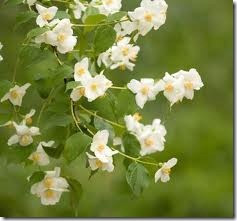Jasmine (Jasminum officinale) is a deciduous climbing shrub native to east Asia and the Himalayas. The white, star-shaped flowers bloom year-round and are intensely fragrant. Jasmine grows 20 to 30 feet tall with a spread of 7 to 15 feet, though it responds well to heavy pruning and can be kept small in a container or in the garden. Jasmine is a warm weather plant hardy in USDA zones 7 to 10. In cooler climates, jasmine must be overwintered in a greenhouse or indoors. Jasmine starts are cuttings from mature plants that are rooted to create a new plant.
Difficulty: Moderate
Instructions
Things You’ll Need:
- Pruning shears
- Knife
- Rubbing alcohol
- Peat
- Perlite
- Sand
- Rooting hormone
- Pot
- Plastic bag
- 12-inch dowel
- Potting soil
- Shovel
-
Take a 9-inch cutting from a mature Jasmine plant between July and late August. Cuttings taken at this time are called semi-hardwood cuttings, according to North Carolina State University Department of Horticultural Sciences. Semi-hardwood wood is the current year’s growth taken in the summer.
Early morning is an ideal time to prepare the jasmine cutting. Select a stalk that has at least three mature leaves on it and make the cut at a 45-degree angle using a knife or a pair of sharp pruning shears. -
Remove the leaves from the lower half of the jasmine cutting by gently bending them back until they snap off or by cutting them off with the pruning shears. Leave three or four leaves at the top of the cutting. When taking multiple cuttings from different plants, dip the tools in alcohol between cuts to avoid spreading disease between cuttings and plants.
-
Fill a 6- to 8-inch pot with a mixture of 1 part peat moss, 1 part perlite, and 1 part sand. Avoid using potting soil, compost, or garden soil. Microbes living in these mediums will cause the cutting to rot before roots are able to form. Dampen the mixture thoroughly until it is crumbly to the touch.
Soil-less rooting mediums are also suitable and available at home and garden centers. -
Roll the end of the cutting in hormone rooting power or dip it in hormone rooting liquid. Both are available at home and garden centers. Make a hole in the center of the pot 4 inches deep using a pencil, dowel or your index finger.
-
Slip the cutting into the hole with the cut end that has the rooting compound on it in the soil and the leafy end above the soil. Drive a 12-inch long dowel into the soil at the edge of the pot. Place a clear plastic bag upside down over the pot so that the bottom of the bag is held up by the dowel. Secure the open end around the lip of the pot. This creates a humid environment to encourage rooting. In a humid greenhouse, the bag is unnecessary.
-
Place the jasmine cutting in indirect sunlight. Remove the plastic bag every 3 to 5 days and mist the leaves with water. If the top of the soil mixture feels dry, add water until it is slightly damp from the top to the bottom. Place the cutting in an area where the temperature is above 75 degrees F. The cutting should root in four to six weeks but could take up to three months.
-
Remove the bag once the cutting has developed roots. To test it, grasp the cutting gently and give it a very gentle tug. If it is firm in the soil, the roots are beginning to form. Wait to check it until the eighth week. Keep the plant indoors for the first fall and winter and transplant outdoors in the spring of the following year.
-
Plant jasmine outdoors in an area that gets full sun and has loamy or sandy soil with good drainage. For a container plant, use a 12- to 15-inch pot filled with a well-draining potting soil mix. Keep the soil moist and apply water when the top 1/4 inch of the soil begins to feel dry to the touch. Place the pot in a sunny location indoors or on a deck or patio.


Deprecated: strpos(): Passing null to parameter #1 ($haystack) of type string is deprecated in /home/agriviek8Qv/agriviet.net/public_html/wp-includes/comment-template.php on line 2522